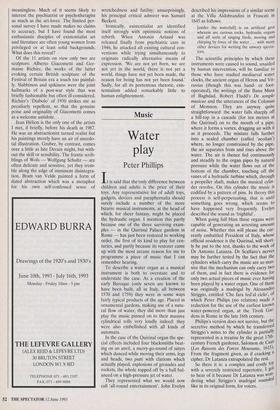Music
Water play
Peter Phillips
It is said that the'only difference between children and adults is the price of their toys. Any representative list of adult toys,, gadgets, devices and paraphernalia should surely include a number of the more bizarre musical instruments, at the head of which, for sheer fantasy, might be placed the hydraulic organ. I mention this partly because one of the three surviving exam- ples — in the Quirinal Palace gardens in Rome — has just been restored to working order, the first of its kind to play for cen- turies, and partly because its restorer came up with the most arcane reason for me to programme a piece of music that I can remember hearing.
To describe a water organ as a musical instrument is both to overstate and to understate the case. As a creation of the early Baroque (only seven are known to have been built, all in Italy, all between 1570 and 1759) they were in some ways fairly typical products of the age. Placed in ornamental gardens, making use of a natu- ral flow of water, they did more than just play the music pinned on to their massive cylindrical rolls very loudly indeed: they were also embellished with all kinds of automata.
In the case of the Quirinal organ the spe- cial effects included four blacksmiths beat- ing on an anvil, a merry-go-round of satyrs which danced while moving their arms, legs and heads, two putti with clarions which actually played, explosions of grenades and rockets, the whole topped off by a ball bal- anced on a high-pressure jet of water.
They represented what we would now call 'all-round entertainment'. John Evelyn described his impressions of a similar scene at the Villa Aldobrandini in Frascati in 1645 as follows:
[under the waterfall] is an artificial grot wherein are curious rocks, hydraulic organs and all sorts of singing birds, moving and chirping by force of the water with many other devices for wetting the unwary specta- tors.
The scientific principles by which these instruments were caused to sound, unaided by human intervention, will be familiar to those who have studied mediaeval water clocks, the ancient organ of Heron and Vit- ruvius (though this was hand- or foot- operated), the writings of the Banu Musa of Baghdad, Robert Fludd's De templo musicae and the utterances of the Colossus of Memnon. They are anyway quite straightforward: the water falls sharply off a hill-top in a cascade (for ten metres at the Quirinal) on to the mouth of a pipe, where it forms a vortex, dragging air with it as it proceeds. The mixture falls further into a sealed chamber (called 'aeolian') where, no longer constrained by the pipe, the air separates from and rises above the water. The air is thence fed continuously and steadily to the organ pipes by natural pressure while the water flows out of the bottom of the chamber, touching off the vanes of a hydraulic turbine which, through a propeller shaft, makes the musical cylin- der revolve. On this cylinder the music is codified by a pattern of pins. In theory this process is self-perpetuating, that is until something goes wrong, which seems to have happened very frequently. Evelyn described the sound as 'frightful'.
When going full blast these organs were capable of generating an arresting amount of noise. Whether this will please the cur- rently embattled President of Italy, whose official residence is the Quirinal, will short- ly be put to the test, thanks to the work of Dr Antonio Latanza. Dr Scalfaro's nerves may be further tested by the fact that the cylinders which carry the music are so mas- sive that the mechanism can only carry two of them, and in fact there is evidence for only two actual pieces of music ever having been played by a water organ. One of these was originally a madrigal by Alessandro Striggio, entitled `Che fara fed'al cielo', of which Peter Philips (no relation) made a reduction for the use of the earliest known water-powered organ, at the Tivoli Gar- dens in Rome in the late 16th century. Philips's version does not survive, but the secretive method by which he transferred Striggio's notes to the cylinder is partially represented in a treatise by the great 17th- century French gardener, Salomon de Cans (Les Raisons des Forces Mouvants, 1615)• From the fragment given, as if cracking 3 cipher, Dr Latanza extrapolated the rest. So there it is: a complex and costly toy with a severely restricted repertoire. I got to hear of it because Dr Latanza was WO' dering what Striggio's madrigal sounded like in its original form, for voices.


































































 Previous page
Previous page